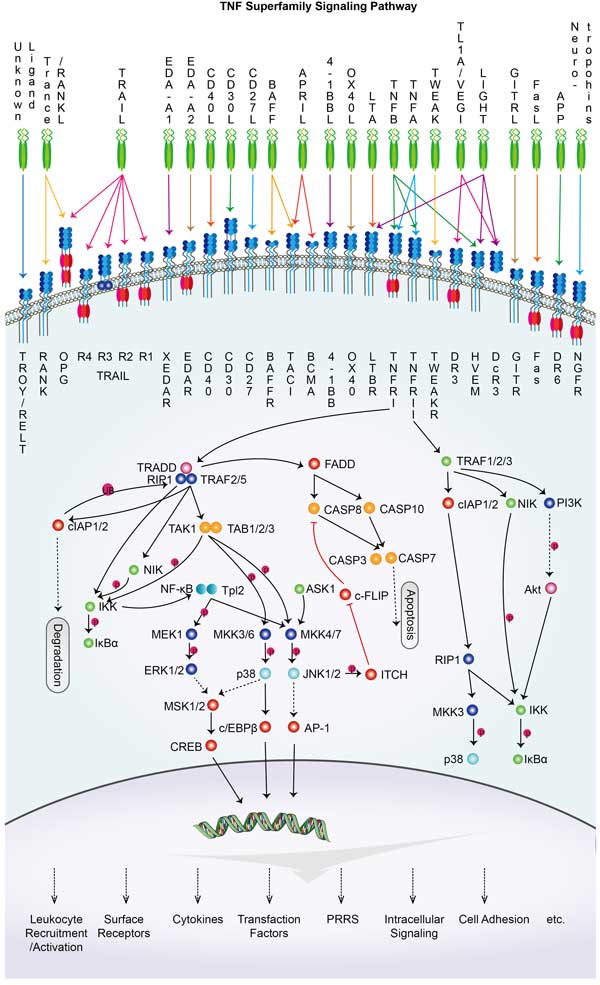Tnfrsf18
-
Official Full Name
tumor necrosis factor receptor superfamily, member 18 -
Overview
This gene encodes a member of the TNF-receptor superfamily. The encoded receptor has been shown to have increased;expression upon T-cell activation, and it is thought to play a key role in dominant immunological self-tolerance;maintained by CD25(+)CD4(+) regulatory T cells. Knockout studies in mice also suggest the role of this receptor is in;the regulation of CD3-driven T-cell activation and programmed cell death. Three alternatively spliced transcript;variants of this gene encoding distinct isoforms have been reported. -
Synonyms
TNFRSF18;tumor necrosis factor receptor superfamily, member 18;tumor necrosis factor receptor superfamily member 18;glucocorticoid-induced TNFR-related protein;AITR;Gitr
Recombinant Proteins
- Cynomolgus
- Mouse
- Human
- Rat
- Rhesus macaque
- Chicken
- Zebrafish
- Canine
- HEK293
- Human Cells
- E.coli
- CHO
- C-His
- Mammalian Cells
- Insect Cells
- His
- Fc
- Avi
- mFc
- Non
- hIgG4
- GST
- Flag
- DDK
- Myc
- mIgG2a
Background
What is TNFRSF18 protein?
TNFRSF18 gene (TNF receptor superfamily member 18) is a protein coding gene which situated on the short arm of chromosome 1 at locus 1p36. This gene encodes a member of the TNF-receptor superfamily. The encoded receptor TNFRSF18, known as GITR, has been shown to have increased expression upon T-cell activation, and it is thought to play a key role in dominant immunological self-tolerance maintained by CD25(+)CD4(+) regulatory T cells. Knockout studies in mice also suggest the role of this receptor is in the regulation of CD3-driven T-cell activation and programmed cell death. The TNFRSF18 protein is consisted of 241 amino acids and TNFRSF18 molecular weight is approximately 26.0 kDa.
What is the function of TNFRSF18 protein?
It is a member of the tumor necrosis factor receptor superfamily. The interaction between GITR and its Ligand GITR-L (Glucocorticoid-induced TNF Receptor Ligand) plays a key role in the development and expansion of regulatory T cells. GITR activation may enhance the immune response by promoting T cell activation, proliferation, and survival. In autoimmune diseases, GITR triggering can produce positive co-stimulatory signals on effector T cells, while GITR activation on regulatory T cells can eliminate their inhibitory function. In addition, GITR activation is associated with increased tumor resistance and viral infection, and may exacerbate autoimmune disease and inflammatory processes.
TNFRSF18 related signaling pathway
GITR-L, the natural ligand for GITR, is primarily expressed on antigen-presenting cells (APCs) such as dendritic cells, macrophages, and B cells. When GITR-L binds to GITR, it triggers a signaling cascade that modulates the immune response. This interaction can lead to the enhancement of T cell activation, proliferation, and survival. GITR signaling can block the canonical NF-κB activation pathway in certain cell types, which is important for controlling inflammation and immune responses. GITR signaling can intersect with other pathways, such as the PD-1/PD-L1 axis, to influence the overall immune response, particularly in the context of cancer immunotherapy.
TNFRSF18 related diseases
TNFRSF18 is a member of the tumor necrosis factor receptor superfamily, which is closely related to the occurrence and development of many diseases. Abnormal expression or function of TNFRSF18 (GITR) has been associated with a variety of diseases. For example, in the field of cancer therapy, GITR agonist antibodies are being studied to enhance the immune response to tumors by reducing the inhibitory activity of Treg cells and increasing the survival rate of effector T cells. In addition, activation of GITR is also being investigated for the treatment of autoimmune diseases, although its role in autoimmune diseases may be more complex and more research is needed to elucidate its full mechanisms and potential therapeutic applications.
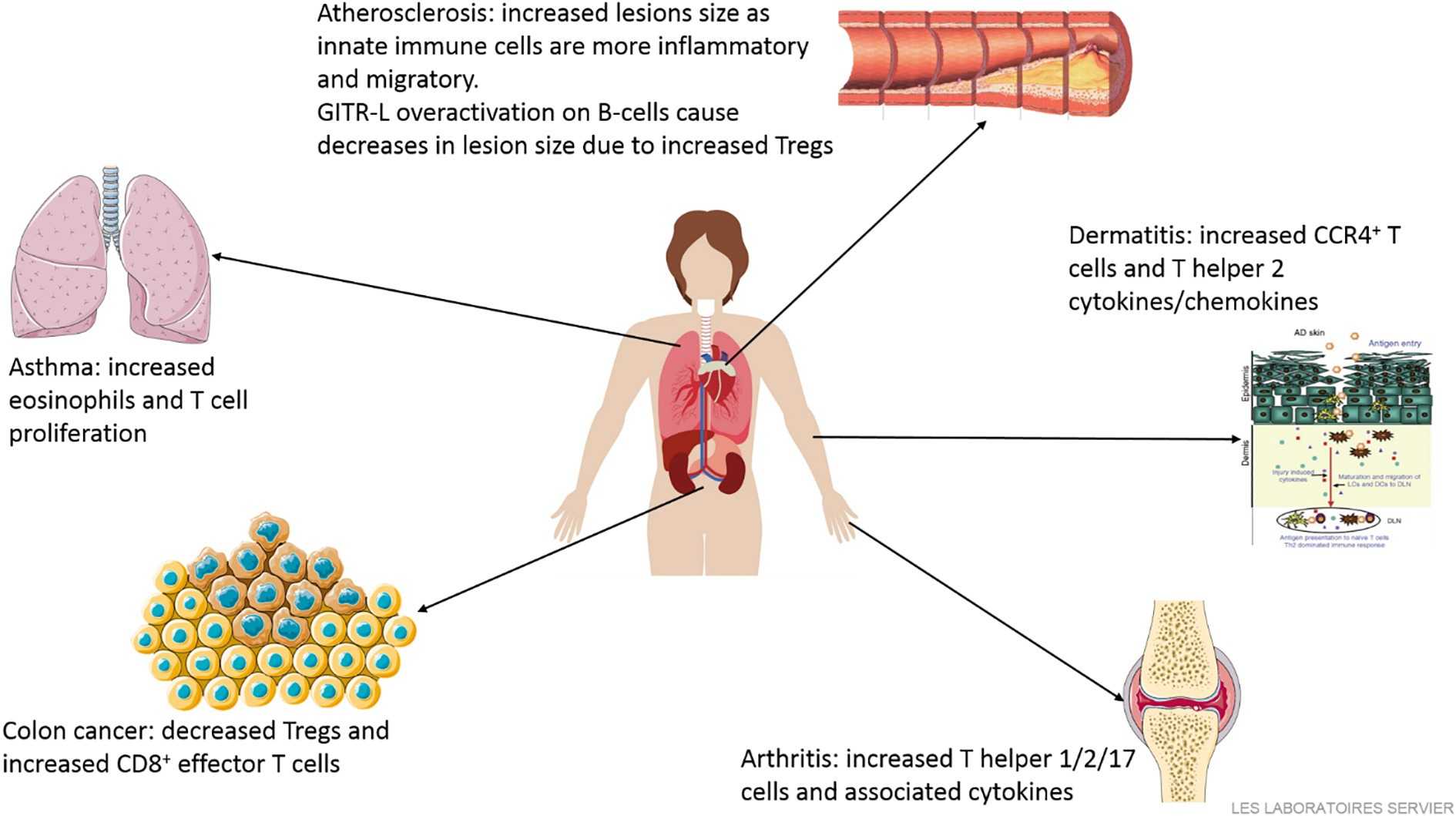
Fig1. The GITR-GITR-L dyad affects different diseases using different mechanisms. (Laura A Bosmans, 2021)
Bioapplications of TNFRSF18
GITR has become a target for immunotherapy, particularly in cancer treatment. Enhancing the immune response to tumors using GITR agonist antibodies is one strategy, and several preclinical and clinical studies are currently underway to evaluate the activity of GITR agonists in solid tumors and other cancer models. In CAR T cell therapy, GITR is also used as one of the co-stimulatory domains to enhance the activity and function of CAR T cells. Some CAR T cell products already contain a GITR co-stimulatory domain. In addition, the expression level of GITR can also be used as a biomarker to provide important information for the diagnosis, monitoring and treatment of tumors.
Case Study
Case Study 1: Sarah Chan, 2022
Costimulatory receptors like GITR are crucial for modulating T cell functions. However, clinical trials of GITR agonist antibodies have had limited success, possibly due to inadequate receptor clustering for effective signaling. To address this, a protein engineering strategy has created a bispecific molecule with an anti-PD-1 antibody linked to a multimeric GITR ligand. This molecule enhances T cell activation and proliferation without relying on FcγR. The binding kinetics of anti-PD-1–GITR-L for cynomolgus PD-1, GITR and FcRn/β2m were determined by SPR. Recombinant TNFRSF18-01C was used in this test. The anti-PD-1–GITR-L construct has shown dose-dependent anti-tumor effects in various mouse tumor models, correlating with target saturation and increased Ki67 and TIGIT on memory T cells. This bispecific approach effectively targets GITR agonism for cancer immunotherapy.
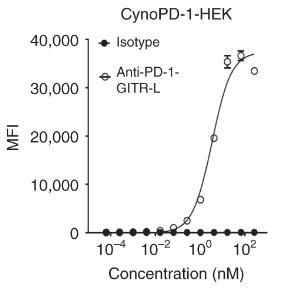
Fig1. Binding of anti-huPD-1-huGITR-L to cynomolgus PD-1.
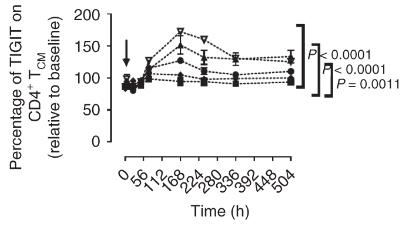
Fig2. Upregulation of TIGIT in CD4+ memory T cells following IV bolus administration of anti-huPD-1-huGITR-L bispecific.
Case Study 2: Yinghao Zhao, 2015
TNFRSF18, known as GITR, has been recognized as a tumor suppressor in Multiple Myeloma (MM) that is often silenced by abnormal DNA methylation. GITR's expression prevents TNFα from activating the NF-κB pathway in MM cells, a process that Bortezomib, a proteasome inhibitor, can counteract, affecting patient responses to the drug. This study investigated whether GITR's status impacts Bortezomib's effectiveness by mediating NF-κB blockade. Results showed GITR is downregulated in MM, and its overexpression can inhibit TNFα-induced non-canonical NF-κB activation and increase Bortezomib's cytotoxicity in GITR-deficient MM cells. Conversely, GITR knockdown reduced Bortezomib's effects and increased NF-κB activation in GITR-proficient cells. Additionally, GITR overexpression heightened Bortezomib sensitivity in bone marrow stromal cells and slowed tumor growth in MM1.S xenograft mice.
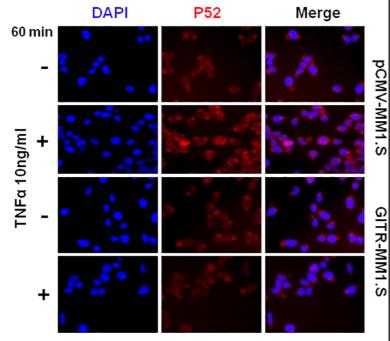
Fig3. pCMV-GITR and GITR-MM1.S cells were harvested at 24 hours after treatment with and without TNF-α.
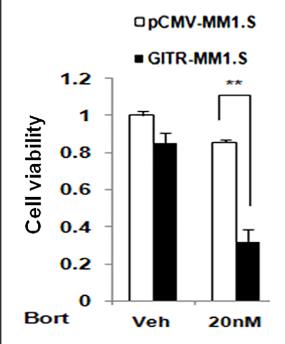
Fig4. Empty vector and GITR-transfected MM1.S cells were treated with Bortezomib for 48 hours.
Quality Guarantee
High Purity
.jpg)
Fig1. SDS-PAGE (TNFRSF18-051H)
.
.jpg)
Fig2. SDS-PAGE (TNFRSF18-2086H)
Involved Pathway
Tnfrsf18 involved in several pathways and played different roles in them. We selected most pathways Tnfrsf18 participated on our site, such as Cytokine-cytokine receptor interaction, which may be useful for your reference. Also, other proteins which involved in the same pathway with Tnfrsf18 were listed below. Creative BioMart supplied nearly all the proteins listed, you can search them on our site.
| Pathway Name | Pathway Related Protein |
|---|---|
| Cytokine-cytokine receptor interaction | TNFRSF11A,CXCR3,IL22RA1,VEGFAB,IL3RA,TNFRSF21,PRL,IFNPHI3,ACVR1L,TGFB1A |
Protein Function
Tnfrsf18 has several biochemical functions, for example, tumor necrosis factor-activated receptor activity. Some of the functions are cooperated with other proteins, some of the functions could acted by Tnfrsf18 itself. We selected most functions Tnfrsf18 had, and list some proteins which have the same functions with Tnfrsf18. You can find most of the proteins on our site.
| Function | Related Protein |
|---|---|
| tumor necrosis factor-activated receptor activity | TNFRSF11B,NRADD,FAS,TNFRSF9A,CD27,TNFRSF4,EDA2R,CD40,TNFRSF8,TNFRSF9 |
Interacting Protein
Tnfrsf18 has direct interactions with proteins and molecules. Those interactions were detected by several methods such as yeast two hybrid, co-IP, pull-down and so on. We selected proteins and molecules interacted with Tnfrsf18 here. Most of them are supplied by our site. Hope this information will be useful for your research of Tnfrsf18.
MYC
Tnfrsf18 Related Signal Pathway
Resources
Gene Families
Related Services
Related Products
References



